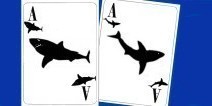|

Join our Newsletter
& get our free guide Starting Hands Revealed
We hate spam too!
We value your privacy and never share your email. All our emails have an opt-out link. Click it, and you will never hear from us again. |
Texas Hold'em Players' Styles"Poker is not a card game played by people. Poker is a people game played with
cards." 
There is hardly a quote describing poker more faithfully. Poker is a game of chance, so of course luck is involved. But over a large number of hands, luck will even out and all players will have the same share of good and bad cards. What differentiate the good, the bad and the ugly players are their style and their understanding of their opponents' style. The primary method to determine a player's style is to characterize his tightness-looseness and his aggressivity-passivity. The first element is tightness, which defines the quality of hands played. The more hands played, the lower the average quality, the looser the player. The second element is aggressivity that defines how much the player leads or just follows the betting action. The more he bets and raises, the more aggressive he is. Three main statistics are used to study a player's style: Voluntarily put into the pot (VPIP) suffices to represent a hold'em player's tightness. For aggressivity, preflop raise (PFR) and aggression factor (AG) are used in conjunction to gauge pre and postflop aggression. The diagram above shows in a plane what varying tightness/aggressivity imply for a player's style, dividing the area into 4 quadrants. The x-axis represents increasing aggressivity whilst the y axis is decreasing tightness. In the lower left quadrant are tight-passive players, aka "rocks" or nits. There are good players because they play extremely carefully but their passiveness costs them in the long run. Moving up clockwise, the next quadrant is "loose-passive". This is a common type often encountered in online poker rooms, particularly beginners and low stakes. These players are also referred as calling stations. They get involved with too many hands and call too many additional bets. They can be difficult to play against though as they do not fold. Next on the right are the "maniacs", very aggressive and loose. They are going to bet many weak or strong hands and it is very difficult to read their hands. Playing against them will add a lot of variance, as their betting pattern is that they like to commit a large part of their stack for almost each hand. Finally the green area, the lower right quadrant it tight-aggressive, this is the recommended strategy, the shark. Sufficiently tight to guarantee only playing premium hands, and aggressive enough to put pressure and instill fear in your opponents. I have marked an area bounded by a red line, and there are 5 red dots inside. This area covers mostly the tight-aggressive plus a little of the other areas. This is where you want to be. Each player has his preferences, this is why this is an area as different styles can coexist and be profitable. The red dots are such examples of appropriate styles. |









